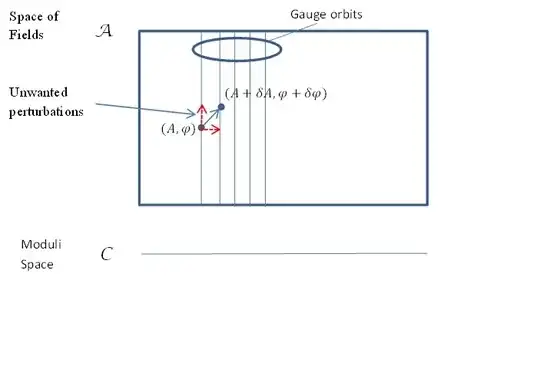The standard way to introduce BPS monopoles is via the Georgi Glashow model on $\mathbb{R}^4$, which is defined by the Lagrangian density $$ \mathcal{L}=-\frac{1}{2}Tr(F^{\mu\nu}F_{\mu\nu})+Tr(D^{\mu}\Phi D_{\mu}\Phi)-\frac{1}{2}(Tr((\Phi)^2)-\alpha^2)^2$$(I won't bother defining all the terms, anyone interested enough to read this will be familiar with them). The E.O.M. are $$D_{\mu}F^{\mu\nu}=[\Phi, D^{\nu}\Phi] $$ $$D^{\mu}D_{\mu}\Phi=-\Phi Tr(\Phi^2-\alpha^2) $$Taking the $\nu=0$ component of the first EOM, we get $$ D_iD_iA_0-D_i\dot{A_i}=[\Phi, [A_0, \Phi]]+[\Phi, \dot{\Phi}]$$This would be something like the equivalent of the Gauss constraint in Maxwell gauge theory. In the temporal gauge $A_0=0$ this becomes $$ D_i\dot{A_i}+[\Phi, \dot{\Phi}]=0 \ \ \ (1)$$Now if we imagine perturbing one minimum energy monopole configuration into a nearby one, the components of the tangent vector to the space of solutions are just the time derivatives of the fields in the perturbation. An example of such a perturbation would be a bodily shift of the monopole from one point to an infinitesimally separated point.
Starting with a solution $(A_i, \Phi)$ of the Bogomolny equations, the author of the reference in the question considers a perturbed solution $(A_i+\delta_{\alpha}A_i, \Phi+\delta_{\alpha}\Phi)$ where $\alpha$ parametrizes the perturbation. Since $\delta$ is small, the perturbation $(\delta_{\alpha}A_i, \delta_{\alpha}\Phi)$ satisfies the linearized Bogomolny equation which would be something like $$\epsilon_{ijk}(D_j\delta_{\alpha}A_k-D_k\delta_{\alpha}A_i ) = D_i\delta_{\alpha}\Phi + [\delta_{\alpha}A_i, \Phi]$$ Now lots of solutions to this equation will arise from perturbations which arise from applying infinitesimal small gauge transformations to the starting point $(A_i, \Phi)$. However physically meaningful solutions must satisfy (1), i.e. $$ D_i(\delta_{\alpha}A_i)+[\Phi, \delta_{\alpha}\Phi]=0 \ \ \ (2) $$(Here it is understood that the covariant derivative is evaluated using the connection at the point at which the tangent vector is attached, i.e $(A_i, \Phi)$). (2) is the background gauge condition.
Now, for the purposes of identifying tangent vectors to the moduli space (fields modulo small gauge transformations), we want a way to filter out any infinitesimal perturbation of a solution $(A_i, \Phi)$ which is just given by an infinitesimal gauge transformation. An unwanted perturbation of this type would be of the form $$(D_i\Lambda, [\Lambda, \Phi]) \ \ \ (3)$$ where $\Lambda$ is some arbitrary Lie algebra valued function.
Now we can define an inner product on the space of fields. For a pair of infinitesimal perturbations $(\delta_{\alpha}A_i, \delta_{\alpha}\Phi)$ and $(\delta_{\beta}A_i, \delta_{\beta}\Phi)$ of a field (i.e. tangent vectors at the point representing the field) we can define their inner product $$ (\delta_{\alpha}A_i, \delta_{\alpha}\Phi)\cdot(\delta_{\beta}A_i, \delta_{\beta}\Phi)\equiv \int d^3x \{Tr(\delta_{\alpha}A_i\delta_{\beta}A_i)+Tr(\delta_{\alpha}\Phi\delta_{\beta}\Phi)\}$$Suppose then we look for perturbations orthogonal to the unwanted transformations of the form (3) - see the diagram below.$$ 0=(\delta_{\alpha}A_i, \delta_{\alpha}\Phi)\cdot(D_i\Lambda, [\Phi,\Lambda])$$ $$=\int d^3x \{Tr(\delta_{\alpha}A_iD_i\Lambda)+Tr(\delta_{\alpha}\Phi[\Phi,\Lambda])\} $$Integrating the first term by parts (assuming $\Lambda$ vanishes at spatial infinity), and using the cyclic property of trace on the second, our condition for orthogonality becomes $$ \int d^3x \{Tr(D_i(\delta_{\alpha}A_i)\Lambda)+Tr([\Phi,\delta_{\alpha}\Phi]\Lambda)\} =0 $$But this is ensured by our background gauge condition (2), so this is indeed the condition for filtering out the unwanted transformations.

